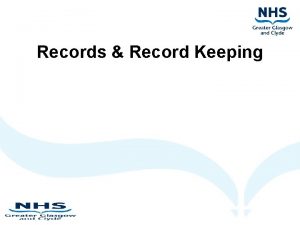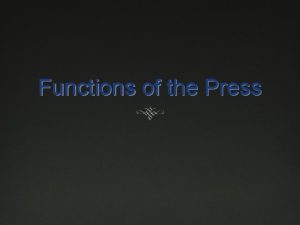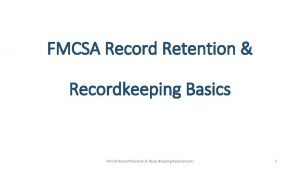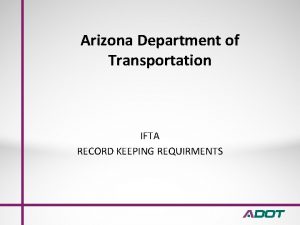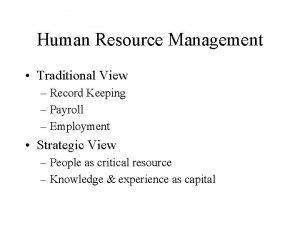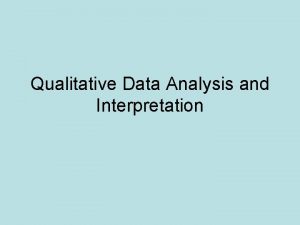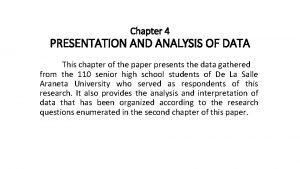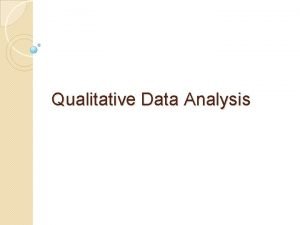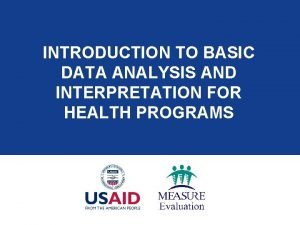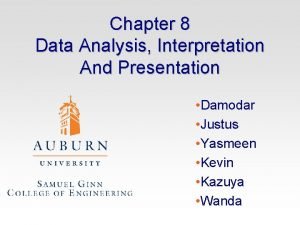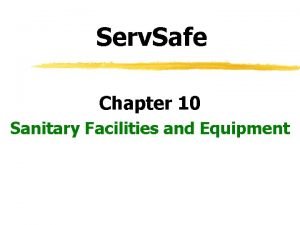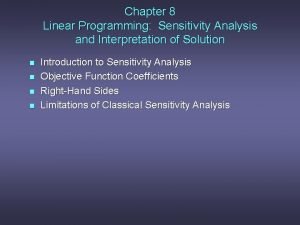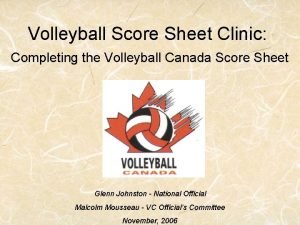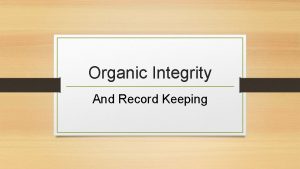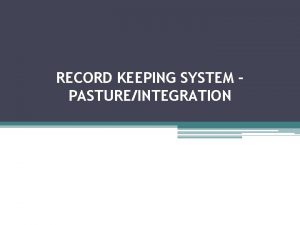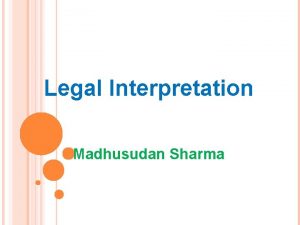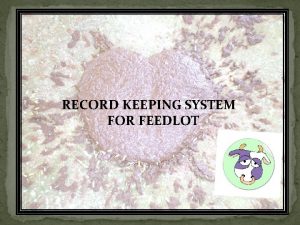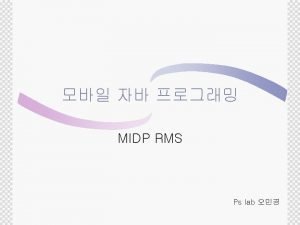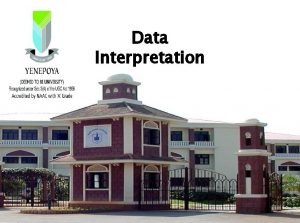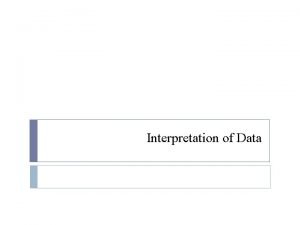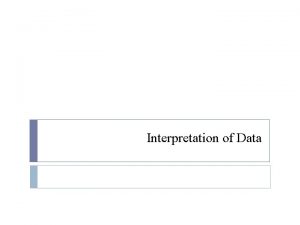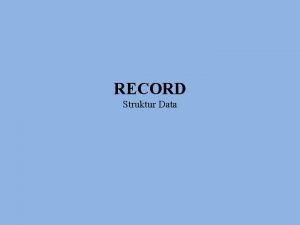DATA ANALYSIS AND INTERPRETATION RECORD KEEPING DATA ANALYSIS




































- Slides: 36

DATA ANALYSIS AND INTERPRETATION & RECORD KEEPING

DATA ANALYSIS AND INTERPRETATION In the operation of a pollution control system, relevant data need to be collected on a scheduled basis for several purposes, such as: • to establish equipment performance, • to determine current process conditions, • to establish regulatory compliance status, and • to identify trends (in process conditions and compliance status).

Informed decision making • Over a period, a large volume of data is collected which need to be managed effectively, analyzed systematically, interpreted in a technically sound manner, presented in a suitable format for informed decision making by the top management.

Data sources • In the operation of STS/IETS, data are collected from several sources such as: (i) Measurements and analyses conducted in the laboratory (ii) Instrument readings by using portable instruments or on-line instrumentation system.

Types of PM data § The PM data of biological processes may include: flowrate, BOD, COD, p. H, ORP, MLSS, MLVSS, SVI, D. O. , OUR, SOUR, VFA, nutrients, microscopic examination, and sludge depth. § The performance monitoring data of physical chemical processes include: flowrate, T, p. H, ORP, pressure, COD, metal concentration, color, chemical dosing rate, metering pump setting, and observation of floc formation,

Data handling techniques • Over the years, STS/IETS practitioners have adopted common ways of handling the PM data that are appropriate for making useful interpretation for the purpose of STS/IETS operation. • The common data handling techniques are discussed in the following paragraphs.

Data tabulation • The in-situ measurements and instrument readings of the treatment processes taken by the field technicians must be recorded in suitables/log sheets. • These tables/log sheets will be inspected by the DOE inspectors when they come to the premises on their inspection duties.

Comparing the measured data with the recommended ranges • As mentioned previously, close monitoring of the STS/IETS processes is a prerequisite for successful operation of the system. • The performance monitoring data recorded by the field technicians in the tables/log sheets must be reviewed by the Competent Person on a regular basis.

Review of PM parameters • The data for the relevant parameters need to be compared with the recommended ranges to ensure the intended processes are occurring in the treatment units in an optimal fashion.

Warning level • The recommended ranges for the PM parameters can be referred from the Guidance Document on Performance Monitoring of IETS. • Additionally, it is also a normal practice that a more conservative value is set for each parameter to serve as a “warning level” to alert the STS personnel to initiate response actions when the “warning level” is reached.

Display of alarm levels • For certain parameters which are monitored on line, these alarm levels may physically be displayed as “warning lights” at prominent locations in the STS/IETS area, or as “flashing lights” on computer screen or may trigger a message (email or sms) to be sent to the relevant STS/IETS personnel

Range control charts • Range control charts are parameter “boundary limits that demarcate the acceptable region where the values of the PM parameters should fall within. • Anytime a value falls outside this acceptable region, it would mean that the intended process (physical, chemical or biochemical) may not occur in a satisfactory manner.

Investigation • This must be immediately investigated to prevent situation developing into a process upset

Range control charts • Range control charts can be easily plotted by using a statistical package commonly available on a personal computer. • The facilities in Microsoft Excel can be used for plotting the data and control charts for the relevant performance monitoring parameters for Biological of Physical Chemical Processes.

Fig. 1 Daily Variation of Pressure Value in DAF Tank

• The pressure readings were within the reference value (60 – 75 psi) for the whole month except for three days (8, 9 and 26 Apr 2011) in which the readings were slightly below the minimum pressure reference value i. e. 60 psi. • The pressure within the saturation tank can be increased or decreased by opening or closing the back pressure valve. • By increasing or decreasing the pressure, a change in recycle flow will result. • The optimum recycle flow and retention tank pressure are determined through experimentation.

Fig 2: Graph of A/S in DAF versus time

• Air to solids ratio is the quantity of air introduced into the recycle stream. • The more air dissolved in the recycle stream, the greater the number of micro bubbles released in the flotation tank. The more micro bubbles produced, the greater the probability of bubble particle contact. • This in turn will allow the DAF operation to be more efficient. • A/S ratio in a DAF unit should be maintained between 0. 03 to 0. 05 kg/kg

Fig 3: Graph of ORP versus time (reduction of hexavalent chromium)

• In the first stage of Chromium Removal, ORP value should be maintained between +250 m. V and +300 m. V to reduce Hexavalent Chromium to Trivalent Chromium. • p. H value must be controlled within 2 to 3

Fig 4: Graph of p. H in second tank versus time (chromium hydroxide precipitation)

• In the second stage of Chromium Removal, p. H value should be maintained between 8 and 9 to precipitate Chromium Hydroxide

Fig. 5 Daily Variation of DO Concentration in Aeration Tank 1 and 2

• DO value should be maintained between 2 – 4 mg/L in a CAS system • DO value were out of the recommended range on November 9, 2011, November 19, 2011, November 20, 2011 November 21, 2011 and November 22, 2011 for both tanks i. e. below the minimum reference value (2 mg/L). • The low DO concentration could be due toxic or shock loads. • An oxygen limited growth environment may promote the predominance of filamentous organisms affecting the settleability of sludge.

Fig. 6 Daily Variation of MLSS Concentration in Aeration Tank 1 and 2

• MLSS is commonly used to represent the microorganisms in biological treatment processes. • Typically the MLSS concentration should be maintained within the range of 1500 to 3000 mg/L for a conventional activated sludge.

Fig. 7 Daily Variation of p. H Value in Aeration Tank 1 and 2

• p. H value in both aeration tanks was maintained consistently within the reference value. • The readings were less than 8. 5 i. e. maximum reference value but remained above 6. 5 i. e. minimum reference value for the whole month. • This premise has implemented an excellent practice in monitoring the p. H which resulted in constant compliance with the reference range.

RECORD KEEPING, REPORTING, AND COMMUNICATION

Importance of record keeping practice and communication • Record keeping plays an crucial role in the operation of an STS/IETS. • It is a fundamental part of self-regulatory approach in pollution management and an essential element in self demonstration of compliance. • Record keeping also serves as an effective management tool in ensuring STS/IETS is being operated, maintained and managed in an optimal manner. • STS/IETS issues need to be communicated through all levels of factory management to promote, inculcate collective concerns and responsibilities on environmental compliance among key personnel in the factory.

Legal requirements on record keeping • Records of operation, maintenance and performance monitoring must be maintained as required under Regulation 20 of the Sewage Regulations 2009 and Regulation 27 of the IER 2009. • Record Keeping includes : i. Hardware maintenance record; ii. The in-situ measurements and instrument readings of STS/IETS components taken by field technicians need to be recorded in suitables/log sheets; and iii. Records of upset conditions and corrective actions taken to address them.

Maintaining records of Performance Monitoring data • The data generated from performance monitoring activities are to be recorded in a suitable format which would facilitate easy understanding and retrieval. • During inspection duties the DOE inspectors will request for these data hence it is advisable that a separate file containing the data is kept at hand. • Soft copies of the data can be stored in a database while hard copies can be kept in the file for easy reference. • Another important record to be maintained is the record on “corrective actions” taken to address upset conditions.

1. Sample of Performance Monitoring Test Results Presenting in a Table Format Supervisor: Operator: Shift No: Date Sample Taken: Date Test Done: Sampling Location Test Parameter Unit Mean Reference Range COD mg/L BOD 5 mg/L MLSS mg/L 1500 -3000 c MLVSS mg/L 1500 -2000 c DO mg/L 2. 0 -4. 0 e OUR mg O 2/L/h SOUR mg O 2//h/g 2. Aeration Tank p. H 12 -20 f 6. 5 -8. 5 Temperature o. C SV 30 m. L SVI m. L/g <40 [50 -100, Good]g N: P 5: 1 h F/M 0. 1 -0. 5 BODbasis-Conv 0. 15 -0. 7 i CODbasis-Conv Measured QRAS m 3/d Return Flowrate, QR m 3/d Notes

1. Sample of Performance Monitoring Test Results Presenting in a Table Format Supervisor: Operator: Shift No: Date Sample Taken: Date Test Done: Sampling Location Test Parameter Unit Mean Reference Range 2. Chrome reduction tank p. H ORP 3. Ph adjustment p. H 4. Coagulation tank p. H 2 -3 m. V 9 -11 PAC dosage 5. Flocculation tank 200 -350 p. H Polymer dosage 6. Secondary Clarifier COD mg/L Cr 6+ mg/L Zinc mg/L Nickel mg/L Notes

Data and report certification • All the forms on which the data are kept must be signed by the STS/IETS personnel taking the measurements and the forms are to be countersigned by the Competent Person.

How long should you keep performance monitoring data? • Performance monitoring data should be kept for a minimum period of three (3) years.
 Record keeping and budgeting
Record keeping and budgeting Record keeping and writing
Record keeping and writing Nmc record keeping guidance 2009
Nmc record keeping guidance 2009 Three functions of press
Three functions of press Fmcsr 395
Fmcsr 395 Ifta record keeping requirements
Ifta record keeping requirements Record keeping system for small business
Record keeping system for small business Sssmzp
Sssmzp Ankle sprain soap note
Ankle sprain soap note Ifta record keeping requirements
Ifta record keeping requirements Traditional record keeping
Traditional record keeping Ferpa record keeping requirements
Ferpa record keeping requirements Cacfp record keeping requirements
Cacfp record keeping requirements How does interpretation b differ from interpretation a
How does interpretation b differ from interpretation a Specimen record observation example
Specimen record observation example Example of analysis and interpretation of data
Example of analysis and interpretation of data Analyze vs interpret
Analyze vs interpret Chapter 4 research data analysis
Chapter 4 research data analysis Data analysis and interpretation examples
Data analysis and interpretation examples Methodology triangulation
Methodology triangulation Nnrims
Nnrims Data analysis, interpretation and presentation
Data analysis, interpretation and presentation Keeping orchids poem
Keeping orchids poem Short poem on peacock
Short poem on peacock Sanitary equipment facilities definition
Sanitary equipment facilities definition Counterargument
Counterargument Keeping an infant safe and well section 7-3
Keeping an infant safe and well section 7-3 Keeping an infant safe and well section 7-3
Keeping an infant safe and well section 7-3 Keeping the company on track and making sure goals are met
Keeping the company on track and making sure goals are met An institution for receiving keeping and lending money
An institution for receiving keeping and lending money Building keeping and growing profitable value-laden
Building keeping and growing profitable value-laden What do you see in this picture
What do you see in this picture 100 rule sensitivity analysis
100 rule sensitivity analysis The end and thank you images
The end and thank you images Alliteration in keeping quiet
Alliteration in keeping quiet Hussain manawer poems
Hussain manawer poems Old tongue poem
Old tongue poem


